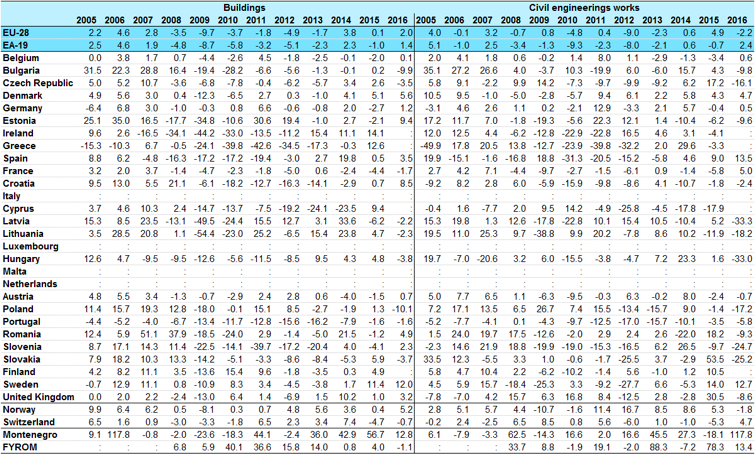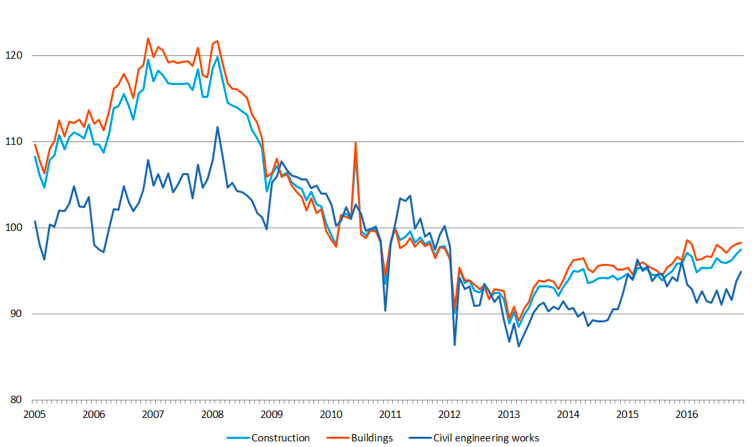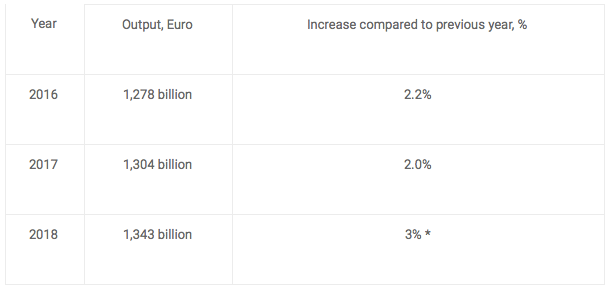Productivity growth in the construction industry has increased the rate of employment and has greatly contributed to Europe’s economy. Providing more than 18 million jobs with a value amounting to 8.6% of the EU’s total GDP (Gross Domestic Product) in 2016, the construction sector is highly important in the European Union.
Additionally, the sector also presents creative and innovative solutions for current social, climate, and energy challenges. About 42.9 million workers in Europe depend on the construction industry. The internal market gives international EU partners access to more than 500 million people amounting to about 13 trillion euros in GDP.
Learning from the 2008 crisis
Ten years ago during the 2008 crisis, the European construction sector got hit really hard. Declines in production were experienced in most countries from -54.4% production rate in Lithuania in 2009 while other countries like Germany and Austria reached almost stable production levels.
![]()
Estonia, Ireland and Spain, on the other hand, had declining growth rates before the year 2009. In most countries, construction activities suddenly dropped. Negative growth was apparent in the entire European Union until 2013. Growth rates followed for the EU-28 construction sector.

Rates of change for buildings and civil engineering works between 2005 to 2016. Image from Eurostat.
EU construction output grew from year to year until it suddenly dropped from 2008 onwards. From 2008 to early 2013, a constant decline was seen in the overall construction in the EU-28 (even with a brief spike in 2010). The index showed more than 30% points loss on average.
Production somehow started recovering in 2013 and 2014 with an increase of about 6% points. The continuous increase in construction production in 2016 shows only an 80% level of the pre-crisis construction output peak. However production has been increasing very slowly especially for countries in the Euro zone (EA-19). This growth shows slower recovery than the average level of EU-28 countries.

Total construction activity from 2005 to 2016. Image from Eurostat.
Currently, residential and non-residential projects amount to 78% (0.997 billion euros) of total construction output in the EU-28, while civil engineering works like railways, roads, bridges and other similar infrastructure projects amount to 22% (0.218 billion). The effects of the economic crisis were far less visible for civil works as compared to building constructions (especially in Spain).
Post-crisis: Getting back up
Construction activity and productivity in the whole EU sector has grown by 2.2% in 2016 (about 1.278 billion euros) with a similar case in 2017 of more than 2% growth. A larger increase of 3% is forecasted in 2018 which equates to about 1.343 billion euros.
However, in order to reach pre-crisis production output levels, investments and time are still needed. That’s why having a planned construction investment strategy is highly important. You can see this in Germany’s construction sector with their no-public-investments-on-credit legal measures for building.

*Forecast by the European Construction Industry Federation (FIEC) for their annual report for 2017.
Green building initiatives will increase revenues for the European construction sector as it has roles and responsibilities in adapting buildings to climate change (e.g. smart buildings and building energy performance metrics). The Energy Efficiency Plan 2011 is set for 3% of all public structures to be renovated per year until 2020.
Following 2020, all new buildings must be carbon-neutral for EU-27 countries. As the construction trends push for more countries to go energy efficient and environmentally friendly, European construction innovations will impact the overall global construction sector. European construction is now even greener and more sustainable than before and ready to return to steady economic growth.
“Construction demand is rising in all 19 member countries in 2017. This is the first time that growth has been seen across the board in Europe since Germany’s reunification; and it looks like this feat will be repeated in 2018.”
– Ludwig Dorffmeister, Euroconstruct
A steady recovery path
With the influx of migrants and cheap forms of credit, residential construction has greatly improved since 2016. Construction output in France, Germany and the UK continues at a sustainable level while output in smaller countries has picked up following the previous years’ low output.
Since declining in 2016, non-residential construction continue to recover with 2–3% growth forecast for 2018/2019. Office construction is expected to perform above the averages as it recovers from a period of significant contraction. Improvements in the Netherlands, Belgium and Denmark markets are expected.
Overall outlook is positive for the European construction industry and sector productivity is expected to grow steadily during 2018.
Articles on specific construction economic trends can be found here.




